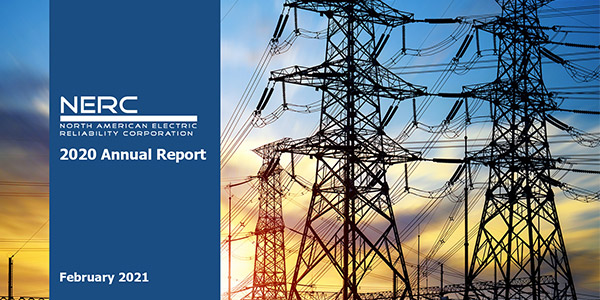In its annual report released Monday, NERC applauded the ERO Enterprise for advancing the reliability and security of the power grid during a year that was “extraordinary on so many dimensions.”
Achievements highlighted in the report include the organization’s response to the COVID-19 pandemic, along with progress toward securing the bulk power system supply chain and improving cybersecurity practices at utilities.
“While I think we will all be happy to see 2020 in the rearview mirror,” CEO Jim Robb wrote in the report, “we can all be very proud of what we have accomplished and what we have learned about collaboration and resilience.”
COVID-19 Captured Attention
Public and private sector organizations across the world spent considerable effort grappling with the pandemic, which has led to around 500,000 deaths in the U.S. over the past year, according to the CDC, and the bulk power system was no exception. Efforts by FERC, NERC and the regional entities to help utilities adapt to the rapidly changing situation play a significant role in the annual report.
The report highlights three main initiatives:
- Easing compliance burdens to allow registered entities to focus on COVID-19 response through measures such as deferring audits and other on-site activities and expanding the ERO Enterprise self-logging program (See ERO Pandemic-related Measures Extended Again.)
- Collecting information to promote situational awareness and sharing it with industry via a Level 2 alert issued in April (See Industry Pandemic Prep Encouraging, NERC Says.)
- Coordinating with government partners to ensure alignment between industry and regulators.
In addition, the Electricity Information Sharing and Analysis Center (E-ISAC) has been actively working with industry to highlight additional risks that might arise from the pandemic, including heightened vulnerability to cyberattack caused by employees working remotely and “potential supply chain issues … from a manufacturing slowdown in Asia.”
“These efforts continue to enable the ERO Enterprise to fulfill its unique and vital mission of assuring the reliability, resilience and security of the North American BPS during this uncertain time,” the report said.
Supply Chain Focus
The ERO’s work on supply chain security in 2020 went far beyond the pandemic, with several projects initiated last year aimed at preventing foreign interference in the grid through sabotage of electronic components.
Among these efforts was NERC’s second Level 2 alert of the year, issued in July in response to former President Trump’s declaration of a national emergency regarding foreign-made equipment in the BPS. (See Trump Declares BPS Supply Chain Emergency.) The report emphasized that efforts initiated by the Department of Energy and other agencies in response to Trump’s order would support activities “already underway in NERC’s supply chain standards and other work.”
Separate from the order, the organization also published a joint white paper with FERC sharing techniques that utilities can use to identify the manufacturers of equipment on their systems, information often difficult for them to access. (See FERC, NERC Offer Cyber Supply Chain Guidance.) Additional actions mentioned in the report include updates to NERC’s critical infrastructure protection standards in Project 2019-03 (Cyber security supply chain risks), which NERC’s Board of Trustees approved for filing with FERC in November. (See “Standards Actions,” NERC Board of Trustees/MRC Briefs: Nov. 5, 2020.)
Efficiency Achievements
Improving efficiency and effectiveness across the ERO Enterprise was another critical focus of NERC in 2020 “brought to the forefront by the pandemic.” Despite disruptions, NERC achieved several key milestones in these projects last year.
On the organizational side, NERC’s new Reliability and Security Technical Committee (RSTC) managed a smooth transition from its predecessor organizations, the Planning, Operating and Critical Infrastructure Protection Committees. (See RSTC Tackles Organization Issues in First Meeting.) The report credited RSTC leadership with moving ahead with a successful reorganization despite being forced to hold meetings remotely through most of the year.
NERC’s Align software project also moved ahead in 2020, along with the Secure Evidence Locker. The projects are intended to improve and standardize compliance monitoring and reporting processes across the ERO Enterprise; registered entities entered the first phase of training earlier this year, with the Midwest Reliability Organization and Texas RE leading the way. (See MRO, Texas RE to Lead Align Software Training.)
In the report’s conclusion, NERC’s outgoing Board Chair Roy Thilly commended the “seamless” adaptation by the ERO Enterprise to the swiftly changing circumstances of 2020. He called the relationship between NERC and the REs entering 2021 “the strongest [and] most productive … in [their] history,” which he said would be crucial to their future success.
“[Risks] to the grid are constantly changing. Cyber and physical attacks present major threats that require constant attention. Severe weather risks from hurricanes, droughts, unprecedented hot spells and wildfires are growing,” Thilly warned. “[But] while it is impossible to eliminate all risk or predict the future, we can say with confidence that NERC, the regional entities and industry are well-positioned to succeed.”




